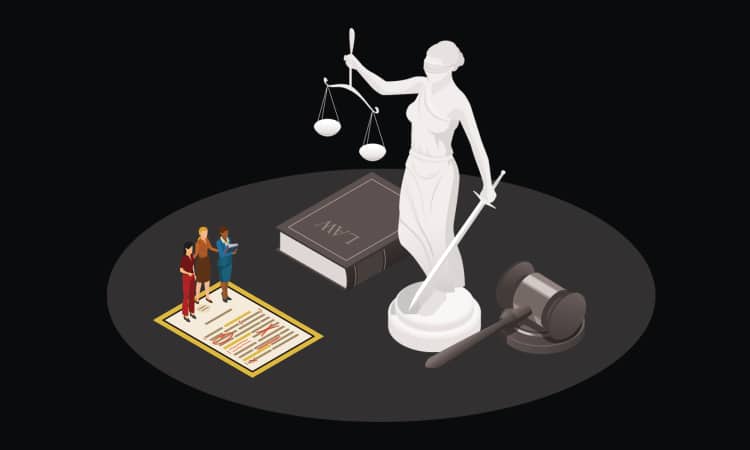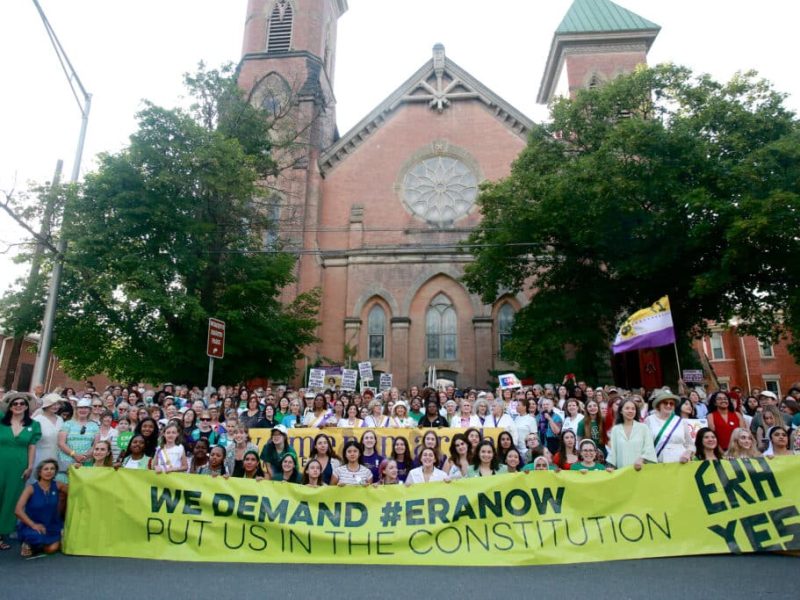
The House Judiciary Committee held the first Congressional hearing on the amendment in more than three decades on April 30. Supporters of the ERA argued that its resurrection was desperately needed. Opponents wanted it to stay buried. The conservative National Review opined, The Equal Rights Amendment Is Deader than Marley’s Ghost.
But this epitaph is premature. Two states—Nevada and Illinois—have recently ratified the amendment, bringing the total to 37, just one short of the 38 needed for ratification. The key passage at the heart of the ERA is: “Equality of rights under the law shall not be denied or abridged by the United States or by any state on account of sex.” The ERA, if ratified, would provide a strong legal defense against a rollback of the significant advances in women's rights that have been achieved since the mid–20th century.

Without the ERA, women regularly have to fight long, expensive, and difficult legal battles in an effort to prove that their rights are equal to those of the other sex.
But is the ERA necessary?
In a 2010 interview with California Lawyer magazine, the late justice Antonin Scalia said, “Women’s equality is not explicitly protected in the constitution or in the 14th Amendment.” In his words, “Certainly the Constitution does not require discrimination on the basis of sex. The only issue is whether it prohibits it. It doesn’t.” Some critics argue that we don’t need the ERA because women have done ‘just fine' without it. This argument completely ignores a troubling reality. Every time women make great gains, a sustained period of backlash sets in and a retreat follows on women’s rights.
After women were granted the right to vote in 1920, the drive for more gains slowed down. It would take another 45 years for women to win the right to simply use contraception to plan their families. The women’s movement of the 1970s was followed by an extended period of “Post feminism,” and young women avoided the term as if it were a swear word. In 1998, a Time magazine cover asked, Is Feminism Dead? and suggested the answer was ‘yes'.
In 1991, women were enraged over the sexist treatment of law professor Anita Hill when she testified against Supreme Court nominee Clarence Thomas in his Senate confirmation hearing. Hill, who said that Thomas sexually harassed her, was grilled about prurient issues. Senators insisted that she name the pornographic movie Thomas allegedly recommended to her, “Long Dong Silver.”
Women responded by running for political office in greater numbers in the next year than in the past, and winning. Never before had four women been sent to the Senate in a single congressional election. The year 1992 was even dubbed “The Year of the Woman,” but mass political activism around sexual harassment mostly faded, until the #MeToo movement surfaced in 2017.
The ERA could successfully diminish the power of backlash that builds after every major step forward, because when rights are embedded in the Constitution, they are hard to deny. Recall that in the 1970s, Phyllis Schlafly, the ardent, strident and out-spoken enemy of the ERA, issued dire predictions about the aftermath of its passage. “She warned of a dystopian post-E.R.A. future of women forced to enlist in the military, gay marriage, unisex toilets everywhere and homemakers driven into the workplace by husbands free to abandon them,” noted the New York Times. Scare stories abounded, and the amendment fell short of the number of states needed for ratification.
Although the amendment failed, the New York Times reported that, “Much of what she [Schlafly] recoiled from has come to pass: abortions are intact, albeit under siege in some jurisdictions. Same-sex marriage as a right has the Supreme Court’s blessing. Unisex bathrooms are a broadly accepted fact of life, notwithstanding struggles over transgender rights. And women today not only fill the ranks of the military but are also eligible for combat duty.”
But many of these changes resulted from legislation and, as Justice Ruth Bader Ginsburg reminds us, “legislation can be repealed, it can be altered.” Or it can simply ignored. In April, the U.S. Justice Department decided not to defend a federal law banning female genital mutilation. This is a barbaric procedure, unfortunately common in many areas of the world. The section of a women’s genitalia that is key to sexual pleasure is simply cut out of her body. Women’s rights activists have called for the reversal of the decision. (Women's eNews alerted readers to this story on April 26.)
What difference would the ERA make if it were to be made law today? According to the New York Times, it would “guarantee equal legal rights for all American citizens regardless of sex. It would also require states to intervene in cases of gender violence, such as domestic violence and sexual harassment; it would guard against pregnancy and motherhood discrimination; and it would federally guarantee equal pay.” During the 1970s and ’80s, Ruth Bader Ginsburg helped to persuade the Supreme Court to extend the equal protection clause of the 14th Amendment to prohibit unequal treatment on the basis of sex — similar to what the ERA would have done. But supporters said that clause didn’t go far enough, particularly when it comes to violence against women, sexual harassment and equal pay.”
Looking at the history of the gender pay gap shows us why the ERA is needed. This stubborn gap persists despite the fact that the Equal Pay Act was signed in 1963 by President John F. Kennedy. He praised it as a “significant step forward,” but acknowledged that “much remains to be done to achieve full equality of economic opportunity” for women. His words were eerily prescient.
Since then, some gains were made. In 1963, “women who worked full-time, year-round made 59 cents on average for every dollar earned by men.” In the past six decades, women’s earnings have increased, but according to the National Women’s Law Center, the wage gap remains stubborn, with very little change over the past 12 years.
The Institute for Women’s Policy Research (IWPR) finds that “if change continues at the same slow pace as it has done for the past fifty years, it will take 41 years—or until 2059—for women to finally reach pay parity.” For women of color, the rate of change is even slower. The gender wage gap persists in spite of passage of The Equal Pay Act. Gender discrimination, unequal opportunities for advancement, and lack of federal paid parental leave and childcare assistance all contribute to the unequal status quo.
And the fight goes on. Since the 1970s, five states – Idaho, Kentucky, Nebraska, Tennessee, and South Dakota – have attempted to withdraw their approval of the Equal Rights Amendment. There is heated debate over whether states actually have the right to rescind a ratification. Ultimately, the Supreme Court may have to answer this question. And this debate is likely to intensify as we approach the magic number: 38.
Why is it important now?
In 2017, Nevada ratified the amendment, led by democratic State Senator Pat Spearman, “It was then that other states said, ‘Wait a minute, you mean we can still do that?” noted the New York Times. In 2018, Illinois did as well. Then, in February of 2019, Virginia came close to being the 38th and final state needed to ratify the amendment — until the State House killed its progress. “The drumbeat for the ERA is louder than ever before. Women are marching, protesting, running for office – and getting elected – in record numbers. The #MeToo and Time’s Up movements have shined a light on the discrimination that persists in this country. And it is up to us to harness the energy of these movements to break through the final barrier to finally ratify the ERA,” says Rep. Carolyn Maloney (D-NY). “Our rights cannot be subject to the political whims of legislators, judges, or occupants of the White House who do not see women as equal citizens. We will not quit until women are in the Constitution, where we belong. Women are not waiting any longer. We demand full equality now. We demand that it be spelled out in the Constitution. And you know how you spell it? E-R-A.”
Virginia's Victoria Cobb, president of the Family Foundation of Virginia, has led the new movement to defeat the ERA. The Washington Post reports, “Virginia was poised to become the 38th state to ratify it, filling in that three-quarters majority of states required for it to become official. In Richmond, the GOP-led Senate passed the ERA bill [in February 2019]. And celebrities, lawmakers and activists were touting its revival on Capitol Hill in Washington. “But then a tiny subcommittee in Richmond — the House Privileges and Elections subcommittee — voted along party lines to block the amendment from reaching the House floor after heavy lobbying from Cobb.” The Post goes on to note that, “(Cobb) has powerful place in the world of business is her family’s oyster company, where she has worked mostof her adult life. Good thing there’s no sexual harassment or gender discrimination there, right?” Cobb bases most of her objections on abortion, “convincing folks that somehow, if women were to finally be included in the Constitution, it would mean all kinds of public money would be funding abortion.” However, the ERA has nothing to do with abortion.
“Today, we are witnessing a massive cultural shift for women around the globe. As the highest-ranking female elected official in New York – the birthplace of the women’s rights movement – we must lead by example and pass the Equal Rights Amendment now,” says NYS Lieutenant Governor Kathy Hochul. “From the workplace to our health care system, women are being held back by outdated institutional social and economic barriers. Because of our current climate, enacting an ERA on both the state and federal level is more important now than ever. Let's take action and support women around our nation to achieve full constitutional equality. Our generation must take the torch passed on to us by our foremothers and enact a new ERA for the next generation.”
As the battle rages on, Justice Ginsburg, aka The Notorious RBG, has also made one of the best arguments for ratification: “I would like my granddaughters, when they pick up the Constitution, to see that notion—that women and men are persons of equal stature—I’d like them to see that is a basic principle of our society.”


